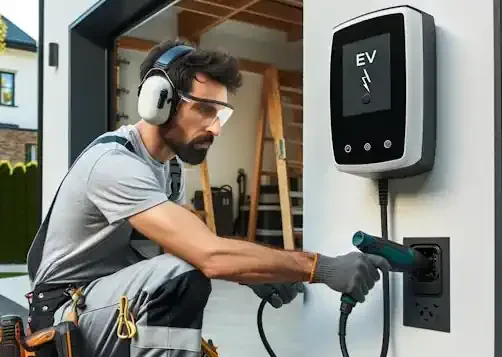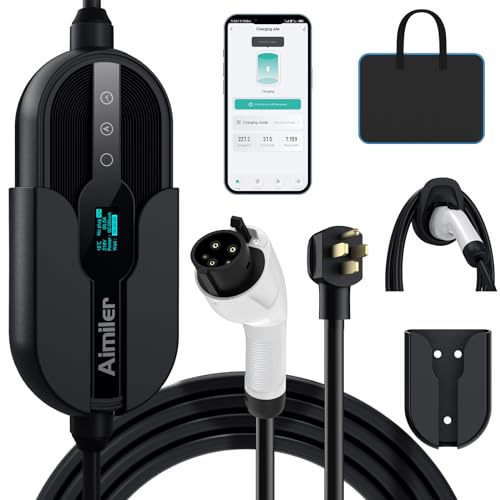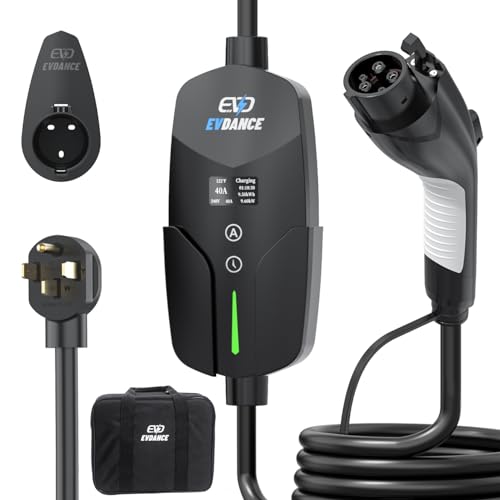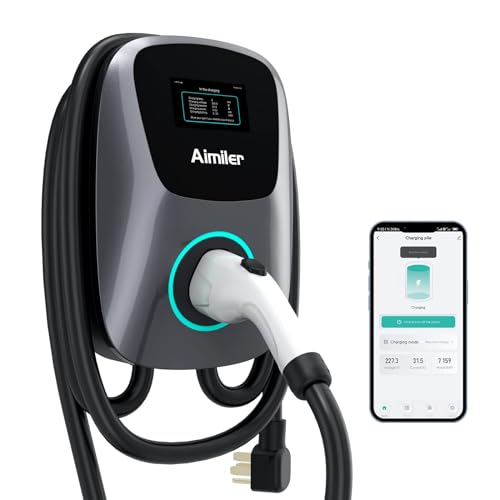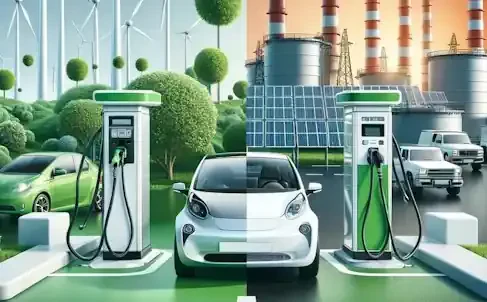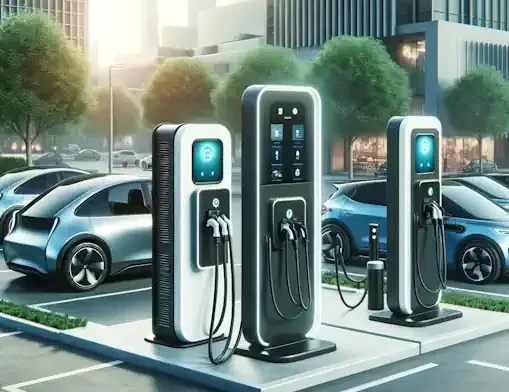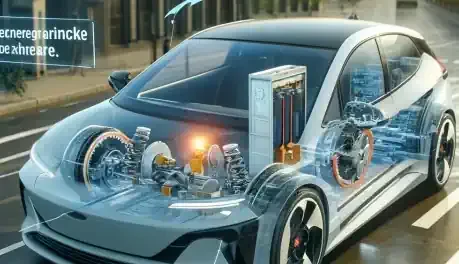Plug and Play Your EV: The Basics
Electric vehicles (EVs) are rapidly growing in popularity, offering a cleaner and more sustainable mode of transportation. However, one common concern for potential EV owners is the perceived complexity of charging. Fortunately, "plug and play" EV chargers have emerged to address this concern, simplifying the installation and operation of home charging stations.
Defining "Plug and Play" in the EV Charging Context: What It Means for EV Owners
In the world of technology, "plug and play" refers to devices that can be easily connected and used without extensive configuration or technical knowledge. When applied to EV chargers, it signifies a hassle-free installation process, often eliminating the need for professional electricians and complex wiring.
For EV owners, this means a smoother transition to electric mobility, allowing them to conveniently charge their vehicles at home without major disruptions or technical challenges.
Key Benefits of Easy Installation Chargers: Cost Savings, Time Efficiency, DIY-Friendliness
Plug and play EV chargers offer a multitude of advantages, making them an attractive option for many EV owners:
Cost Savings: By eliminating or reducing the need for professional installation, plug and play chargers can significantly lower the overall cost of setting up a home charging station. This makes EV ownership more accessible and affordable for a wider range of individuals.
Time Efficiency: The simplified installation process of plug and play chargers means you can start charging your EV sooner. Instead of waiting for appointments and complex installations, you can often have your charger up and running within hours, saving valuable time.
DIY-Friendliness: Many plug and play chargers are designed with the average homeowner in mind, featuring clear instructions and user-friendly components. This empowers EV owners to take charge of the installation process themselves, fostering a sense of self-sufficiency and control.
Common Misconceptions About Home EV Charging: Debunking Myths and Fears
Despite the growing popularity of EVs and the convenience of plug and play chargers, some misconceptions persist about home EV charging:
Overloading Electrical Circuits: Concerns about overloading home electrical systems are common. However, modern homes are typically equipped to handle the additional load of EV charging, especially with Level 1 chargers. Consulting an electrician can address any specific concerns.
Fire Hazards: While any electrical device carries some risk, EV chargers are designed with safety in mind. Choosing reputable brands and following proper installation guidelines significantly minimize fire hazards.
Expensive Electricity Bills: EV charging does increase electricity consumption, but the cost is often lower than fueling a gasoline-powered vehicle. Additionally, many utility companies offer time-of-use rates or special EV charging plans to further reduce costs.
Should You Buy or Lease an EV Charger?: Pros and Cons of Each Option
When deciding to install a plug and play EV charger, you have two primary options: buying or leasing. Each approach has its own set of advantages and disadvantages:
Buying:
Pros: Long-term ownership, potential tax credits or rebates, greater control over customization and upgrades.
Cons: Higher upfront costs, responsibility for maintenance and repairs, potential for outdated technology.
Leasing:
Pros: Lower upfront costs, often includes maintenance and support, the ability to upgrade to newer models easily.
Cons: Ongoing monthly payments, less control over customization, potential limitations on usage or location.
The best choice for you will depend on your budget, long-term EV ownership plans, and desired level of control over your charging setup.
Do You Need a Permit to Install an EV Charger at Home?: Local Regulations and Requirements
The need for permits when installing an EV charger at home varies depending on your location and specific circumstances. Some local governments may require permits to ensure electrical safety and compliance with building codes.
It's crucial to check with your local building department or municipality to determine if a permit is necessary. They can also provide information on any specific requirements or restrictions regarding the installation of EV chargers in your area.
Level 1 vs. Level 2: Choosing The Right Charger For Your Needs
Understanding the distinctions between Level 1 and Level 2 EV chargers is crucial in making an informed decision that aligns with your driving habits, charging requirements, and budget. These two levels represent the primary types of home charging solutions available to EV owners, each with its own set of characteristics.
Understanding Charging Speeds: How Level 1 and Level 2 Differ
The most fundamental difference between Level 1 and Level 2 chargers lies in their charging speeds. Level 1 chargers, also known as trickle chargers, operate on standard household electricity (120 volts) and deliver a relatively slow charge. On average, they can add 2-5 miles of range per hour of charging.
Level 2 chargers, on the other hand, require a dedicated 240-volt circuit, similar to what you might use for a clothes dryer or oven. This higher voltage enables them to deliver a significantly faster charge, typically adding 10-60 miles of range per hour, depending on the charger and your EV's onboard charging capabilities.
When Level 1 Makes Sense: Occasional Drivers, Plug-In Hybrids, Budget Considerations
While Level 2 chargers are undoubtedly faster, Level 1 chargers still serve a valuable purpose for certain EV owners:
Occasional Drivers: If you only drive your EV infrequently or for short distances, a Level 1 charger might be sufficient to replenish your battery overnight.
Plug-In Hybrids: Plug-in hybrids (PHEVs) have smaller batteries than fully electric vehicles, making Level 1 charging a viable option for maintaining their electric range.
Budget Considerations: Level 1 chargers are generally more affordable than Level 2 chargers, both in terms of upfront costs and installation. They are an excellent entry point for those looking to test the waters of EV ownership without a significant financial investment.
Limited Access to 240-Volt Circuits: If your home's electrical panel doesn't have an available 240-volt circuit, installing a Level 2 charger might require costly upgrades. In such cases, a Level 1 charger can be a practical workaround.
The Power of Level 2: Faster Charging for Daily Commuters, Larger Battery EVs
For many EV owners, especially those who rely on their vehicles for daily commuting or longer trips, Level 2 charging is the preferred option due to its superior charging speed.
Faster Replenishment: The ability to add a significant amount of range in a short period is essential for those who frequently use their EVs. Level 2 chargers can fully charge most EVs overnight, ensuring you start each day with a full battery.
Larger Battery EVs: If you own an EV with a larger battery capacity, Level 1 charging might be impractically slow. Level 2 chargers are better equipped to handle the demands of larger batteries, making them a necessity for many EV models.
Convenience and Flexibility: The faster charging speed of Level 2 chargers provides greater flexibility in your daily routine. You can top up your EV's battery during shorter breaks or run errands without worrying about extended charging times.
Preparing for Longer Trips: If you plan on taking your EV on road trips or extended journeys, having a Level 2 charger at home can be invaluable. It allows you to quickly recharge your EV between legs of your journey, minimizing downtime and maximizing your travel time.
Factors Affecting Charging Time: Battery Size, Charger Power Output, Environmental Conditions
While the charging speed of your chosen charger plays a significant role, several other factors can influence how long it takes to fully charge your EV:
Battery Size: EVs come with varying battery capacities, typically measured in kilowatt-hours (kWh). Larger batteries naturally take longer to charge than smaller ones, regardless of the charger level.
Charger Power Output: Even within Level 2 chargers, there are variations in power output. Chargers with higher power output (e.g., 40 amps or higher) can charge your EV faster than those with lower output.
Environmental Conditions: Extreme temperatures, particularly cold weather, can affect charging speeds. Cold temperatures can slow down the chemical reactions within the battery, resulting in longer charging times.
Future-Proofing Your Investment: Upgrading to Level 2 for Long-Term EV Ownership
While Level 1 chargers might be sufficient for some, considering a Level 2 charger is a wise decision for long-term EV ownership.
As battery technology continues to advance, EVs are likely to come with even larger batteries, requiring faster charging speeds. Investing in a Level 2 charger today can ensure that you're prepared for the future of electric mobility.
Additionally, if you plan to upgrade to an EV with a larger battery in the future, a Level 2 charger will be a necessity for maintaining a convenient and efficient charging experience.
Top Plug and Play EV Chargers: 2024's Best Picks
The market for plug and play EV chargers is booming, with numerous brands and models vying for your attention. Choosing the right one can be daunting, but understanding the key features and evaluating the top contenders can help you make a well-informed decision. Let's explore some of the standout options available in 2024.
Highlighting 3-5 specific charger models: Based on Performance, Features, and Reviews
ChargePoint Home Flex: A versatile and highly-rated charger known for its flexible amperage settings (16 to 50 amps) and smart features. It offers Wi-Fi connectivity, allowing you to schedule charging, track energy usage, and access remote controls through a user-friendly app.
Emporia Smart Charger: This budget-friendly option doesn't skimp on features. It boasts smart charging capabilities, integration with home energy management systems, and a sleek design. Its 40-amp output delivers a speedy charge, making it a great value for the price.
JuiceBox 40 Smart EV Charging Station: A popular choice among EV owners, the JuiceBox 40 offers reliable performance, a durable build, and smart features like Wi-Fi connectivity and scheduling. It's known for its user-friendly interface and compatibility with various EV models.
Grizzl-E Smart EV Charger: Designed with extreme weather conditions in mind, the Grizzl-E is a robust and reliable charger. It's known for its NEMA 4 enclosure, making it suitable for both indoor and outdoor installations. It also offers Wi-Fi connectivity and a range of smart features.
Tesla Wall Connector: While primarily designed for Tesla vehicles, this charger can also be used with other EVs with an adapter. It boasts a sleek design, fast charging speeds, and seamless integration with the Tesla app for remote monitoring and control.
Key Factors in the Selection: Portability, Power Output, Smart Features, Brand Reputation
When choosing a plug and play EV charger, several factors should guide your decision:
Portability: If you anticipate needing to move your charger or use it in multiple locations, a portable model might be preferable. However, these often have lower power output than permanently installed chargers.
Power Output: Consider your EV's battery size and charging needs. Higher power output translates to faster charging times, but it may also require electrical upgrades in your home.
Smart Features: Features like Wi-Fi connectivity, scheduling, and energy monitoring can enhance convenience and help you optimize your charging costs.
Brand Reputation: Opt for reputable brands known for quality, reliability, and customer support. Research reviews and ratings to gauge customer satisfaction.
Must-Have Features for Modern EV Chargers: Wi-Fi Connectivity, Scheduling, Energy Monitoring
The following features are increasingly becoming standard in modern EV chargers and can significantly enhance your charging experience:
Wi-Fi Connectivity: Enables remote monitoring and control of your charger through a smartphone app.
Scheduling: Allows you to set specific charging times to take advantage of off-peak electricity rates or ensure your EV is fully charged when you need it.
Energy Monitoring: Tracks your electricity usage and charging costs, helping you optimize your energy consumption and save money.
Safety Features: Look for chargers with built-in safety features like ground fault circuit interruption (GFCI) and overcurrent protection.
Budget-Friendly vs. Premium: Finding the Right Balance for Your Needs and Wallet
Plug and play EV chargers come in various price points, ranging from budget-friendly options to premium models with advanced features. Your budget will naturally play a role in your decision, but it's essential to strike a balance between cost and functionality.
Consider your long-term EV ownership goals and charging needs. If you plan to own your EV for many years and frequently charge at home, investing in a higher-end charger with smart features might be worthwhile. However, if you're on a tight budget or only need occasional charging, a more basic model might suffice.
Remember, the "best" charger isn't necessarily the most expensive one, but rather the one that best aligns with your individual requirements and budget.
How To Install a Plug and Play EV Charger: A Step-By-Step Guide
Installing a plug and play EV charger can be a straightforward process, even for those without extensive electrical experience. With the right preparation and adherence to safety guidelines, you can have your charging station up and running in no time. This guide will walk you through the steps involved in a typical installation, but always consult your charger's manual and local regulations for specific instructions.
Pre-Installation Checklist: Ensuring You Have Everything You Need
Before you begin, gather the necessary tools and materials:
Your chosen plug and play EV charger: Ensure it's compatible with your EV and electrical system.
Outlet or Electrical Panel: Identify the location where you'll plug in the charger or connect it to your electrical panel.
Circuit Breaker: Ensure you have a dedicated circuit breaker for your charger, sized according to the manufacturer's recommendations.
Tools: You'll likely need a screwdriver, drill, level, wire cutters/strippers, and a tape measure.
Safety Gear: Wear safety glasses and gloves to protect yourself.
Simple Instructions for DIY Installation: Clear, Easy-to-Follow Steps
Turn off the Power: Before working on any electrical components, locate and switch off the appropriate circuit breaker to ensure your safety.
Mount the Charger: If your charger requires mounting, follow the manufacturer's instructions to secure it to the wall or pedestal. Use a level to ensure it's straight.
Connect the Wires: Depending on your charger and electrical setup, you'll either plug it into an existing outlet (if compatible) or connect the wires to your electrical panel. Consult an electrician if you're unsure about wiring.
Secure the Connection: Tighten all screws and ensure the wiring is secure and properly insulated.
Test the Charger: Turn the circuit breaker back on and test the charger by plugging in your EV. The charger's lights or display should indicate that it's operational.
Verify Charging: Monitor your EV's charging status to ensure it's receiving power and the battery is charging as expected.
Essential Tools and Safety Precautions: Protecting Yourself and Your Property
Installing an EV charger involves working with electricity, so prioritizing safety is paramount.
Use the Right Tools: Ensure your tools are in good condition and appropriate for the job. Don't use damaged or worn-out tools.
Follow Instructions: Read and carefully follow the manufacturer's instructions for your specific charger model.
Turn Off the Power: Always disconnect the power at the circuit breaker before handling any electrical connections.
Work in a Dry Environment: Avoid working on electrical components in wet or damp conditions.
Ground Fault Circuit Interrupter (GFCI): If your charger doesn't have a built-in GFCI, consider installing one for added safety.
Troubleshooting Common Installation Issues: Dealing with Wiring, Circuit Breakers, etc.
While plug and play chargers are designed for easy installation, you might encounter some common issues:
Charger Not Powering On: Check the circuit breaker to ensure it hasn't tripped. If it has, reset it and try again. If the issue persists, consult an electrician.
Slow Charging: Verify that the charger is plugged into the correct outlet or connected to a dedicated circuit. If you're using a Level 1 charger, the charging speed will naturally be slower than a Level 2 charger.
Error Messages: If your charger displays an error message, consult the manual for troubleshooting steps or contact the manufacturer for support.
Professional Installation vs. DIY: When to Call an Electrician for Help
While many plug and play EV chargers are designed for DIY installation, there are instances where seeking professional help is advisable:
Lack of Experience: If you're uncomfortable working with electricity or unsure about any aspect of the installation process, it's best to hire a qualified electrician.
Electrical Upgrades: If your electrical panel needs an upgrade or you need to install a new 240-volt circuit for a Level 2 charger, it's crucial to have a licensed electrician handle the work.
Complex Installations: Some installations, particularly those involving hardwired chargers or unique electrical configurations, might require professional expertise to ensure safety and proper functionality.
Remember, prioritizing safety and ensuring a proper installation is key to enjoying the benefits of your plug and play EV charger for years to come.
Safety First: Essential Tips For Safe EV Charging
While plug and play EV chargers are designed with user-friendliness in mind, ensuring safety during installation and operation is paramount. Adhering to best practices and understanding potential risks can prevent accidents and ensure a seamless charging experience.
Electrical Safety Best Practices: Grounding, GFCI Protection, Avoiding Overloads
Electrical safety should always be a top priority when dealing with EV chargers:
Grounding: Proper grounding is essential to protect against electrical shock. Ensure your home's electrical system is adequately grounded and that the charger is connected to a grounded outlet or circuit.
GFCI Protection: A Ground Fault Circuit Interrupter (GFCI) is a safety device that quickly shuts off power if it detects an imbalance in electrical current, preventing electrical shock. If your charger doesn't have a built-in GFCI, consider installing one on the circuit for added protection.
Avoiding Overloads: Don't overload your electrical circuits. Ensure that the combined amperage draw of your charger and other appliances on the same circuit doesn't exceed the circuit breaker's capacity. If unsure, consult an electrician.
Regular Inspections: Periodically inspect your charger and wiring for any signs of damage or wear. Replace any damaged components immediately to prevent electrical hazards.
Weatherproofing Your Outdoor Installation: Protecting Your Charger from the Elements
If you're installing your charger outdoors, taking precautions to protect it from the elements is crucial:
Waterproofing: Choose a charger with a high Ingress Protection (IP) rating, indicating its resistance to water and dust. A minimum rating of IP55 is recommended for outdoor installations.
Sun Protection: If possible, install your charger in a shaded area to protect it from prolonged exposure to direct sunlight, which can degrade plastic components over time.
Secure Mounting: Ensure the charger is securely mounted to prevent it from being dislodged or damaged by wind or other weather events.
Regular Cleaning: Keep the charger clean and free of debris, especially after exposure to rain, snow, or dust.
Protecting Your Charger From Theft or Damage: Security Measures, Surge Protection
In addition to weatherproofing, consider these measures to safeguard your EV charger:
Locking Mechanisms: Some chargers come with built-in locking mechanisms to deter theft. Alternatively, you can use a padlock or other security device to secure the charger to its mounting location.
Security Cameras: If your charger is installed in a vulnerable location, consider installing security cameras to monitor the area.
Surge Protection: A surge protector can safeguard your charger from sudden voltage spikes, which can damage sensitive electronic components.
Regular Maintenance For Optimal Performance: Cleaning, Inspections, Software Updates
Maintaining your EV charger is essential for ensuring its longevity and optimal performance:
Cleaning: Regularly clean the charger's exterior with a damp cloth to remove dust and debris. Avoid using harsh chemicals or abrasive materials.
Inspections: Periodically inspect the charger and wiring for any signs of damage or wear. Look for frayed wires, loose connections, or cracks in the casing.
Software Updates: Many modern chargers come with Wi-Fi connectivity and the ability to receive software updates. These updates can improve performance, add new features, and address potential security vulnerabilities.
Fire Safety Tips for EV Charging: Preventing and Responding to Potential Hazards
While EV fires are rare, it's crucial to be aware of the potential risks and take preventive measures:
Use Only Certified Chargers: Ensure your charger is certified by a recognized testing laboratory (e.g., UL or ETL) and complies with safety standards.
Avoid Overcharging: Most modern EVs and chargers have built-in mechanisms to prevent overcharging. However, it's still a good practice to avoid leaving your EV plugged in for extended periods after it's fully charged.
Monitor for Unusual Signs: Be vigilant for any unusual signs during charging, such as burning smells, smoke, or excessive heat. If you notice anything unusual, unplug the charger immediately and contact the manufacturer or a qualified electrician.
Have a Fire Extinguisher Handy: Keep a fire extinguisher rated for electrical fires near your charging station.
By following these safety tips and being proactive in maintaining your EV charger, you can enjoy the convenience and benefits of home charging with peace of mind. Remember, safety should always be the top priority when dealing with electricity and charging your valuable electric vehicle.
The Future of Plug and Play: What's Next In EV Charging
The landscape of electric vehicle charging is constantly evolving, with innovative technologies and trends poised to revolutionize the way we power our EVs. While plug and play chargers have already simplified the process, the future holds even more exciting possibilities for convenient, efficient, and sustainable charging solutions.
Emerging Technologies and Trends: Shaping the Future of EV Charging
Several cutting-edge technologies are on the horizon, promising to further enhance the plug and play experience:
Bi-Directional Charging (V2G): This groundbreaking technology enables EVs to not only draw power from the grid but also send it back, effectively turning your vehicle into a mobile energy storage unit. V2G can help balance the grid, reduce energy costs, and even provide backup power during outages.
Smart Charging Networks: These networks utilize intelligent algorithms to optimize charging schedules based on factors like electricity rates, grid demand, and renewable energy availability. This can lead to significant cost savings and a more sustainable energy ecosystem.
Faster Charging Speeds: Research and development are constantly pushing the boundaries of charging speeds. While Level 2 chargers are currently the standard for home charging, faster options like Level 3 DC fast charging are becoming more accessible for residential use.
Integration with Smart Homes: As smart home technology becomes more prevalent, integrating EV chargers with home energy management systems is becoming a reality. This allows for seamless control and automation of charging, optimizing energy usage and potentially reducing costs.
Wireless Charging: The Ultimate Convenience? Current Limitations and Future Potential
Wireless charging, or inductive charging, eliminates the need for physical cables, offering unparalleled convenience and a cleaner aesthetic. While still in its early stages for EVs, it holds immense potential for the future of plug and play charging.
Current Limitations:
Efficiency: Wireless charging is currently less efficient than wired charging, resulting in slower charging times and potential energy loss.
Cost: Wireless charging systems are more expensive than traditional plug-in chargers.
Standardization: There's no universal standard for wireless EV charging yet, limiting compatibility between different vehicles and chargers.
Future Potential:
Seamless Charging: As technology advances, wireless charging could become the norm, allowing EVs to charge effortlessly by simply parking over a charging pad.
Urban Infrastructure: Wireless charging could be integrated into roads and parking spaces, enabling EVs to charge on the go.
Autonomous Vehicles: Wireless charging could be a key enabler for autonomous vehicles, allowing them to recharge without human intervention.
Smart Charging and Grid Integration: Balancing Energy Demand and Reducing Costs
Smart charging involves leveraging data and communication technologies to optimize charging schedules and manage energy demand. By aligning charging times with off-peak hours or periods of high renewable energy generation, EV owners can reduce their electricity bills and minimize strain on the grid.
Grid integration takes this concept further, allowing EVs to act as flexible loads that can be adjusted to match grid conditions. For example, during peak demand, EVs could temporarily pause charging or even discharge power back into the grid to help stabilize the system.
Vehicle-to-Grid (V2G) Technology: Using Your EV as a Power Source
V2G technology is a game-changer in the world of EV charging, enabling a bidirectional flow of energy between your EV and the electrical grid. This means your EV can not only store energy but also supply it back to the grid when needed.
Benefits of V2G:
Energy Storage: EVs can act as distributed energy storage assets, helping to stabilize the grid and integrate renewable energy sources like solar and wind power.
Revenue Generation: EV owners can potentially earn money by selling excess energy back to the grid during peak demand periods.
Backup Power: In the event of a power outage, V2G-enabled EVs can provide backup power to homes and businesses, enhancing energy resilience.
Government Incentives and Rebates: How to Save on Your EV Charger Purchase and Installation
Many governments offer incentives and rebates to encourage the adoption of electric vehicles and home charging infrastructure. These incentives can significantly reduce the upfront costs of purchasing and installing an EV charger.
Types of incentives:
Tax Credits: These can be federal or state-level tax credits that directly reduce your tax liability.
Rebates: Cash-back incentives offered by utility companies or government agencies.
Grants: Funding programs designed to support the installation of EV charging stations.
Researching the available incentives in your area is essential to maximize your savings and make EV charging more affordable.
Beyond The Home: Plug and Play Charging On The Go
While the convenience of charging at home is undeniable, EV owners inevitably venture beyond their driveways, necessitating access to charging solutions on the go. Plug and play technology isn't confined to home installations; it's expanding into the realm of portable chargers and public charging infrastructure, providing EV drivers with flexibility and peace of mind wherever their journeys take them.
Portable Chargers For Travel and Emergencies: Staying Charged on the Road
Portable EV chargers are a game-changer for long road trips and unexpected situations. These compact devices can be plugged into standard household outlets or higher-powered outlets, offering a convenient way to replenish your EV's battery when dedicated charging stations are unavailable.
Key Considerations for Portable Chargers:
Power Output: Portable chargers come in varying levels of power output, typically ranging from 120-volt (Level 1) to 240-volt (Level 2) options. Higher power output translates to faster charging but might require a dedicated outlet.
Cable Length: Choose a charger with a sufficiently long cable to reach your EV's charging port from the outlet.
Portability: Look for lightweight and compact designs that are easy to transport and store.
Safety Features: Ensure the charger has built-in safety features like overcurrent protection and ground fault detection.
Beyond Road Trips: Portable chargers can also serve as a backup power source during emergencies or power outages, providing a crucial lifeline for essential devices or appliances.
Public Charging Etiquette and Tips: Sharing Stations, Avoiding "ICEing"
Public charging stations are an essential part of the EV infrastructure, but they come with their own set of etiquette and considerations:
Share the Space: Be mindful of other EV drivers who might need to charge. Avoid occupying a charging station for longer than necessary, especially during peak hours.
Avoid "ICEing": This term refers to internal combustion engine (ICE) vehicles parking in EV charging spots. Be courteous and avoid blocking these spots if you're not charging an EV.
Cable Management: Keep charging cables neatly organized to prevent tripping hazards and ensure easy access for other drivers.
Respect Charging Limits: Some public chargers have time limits or fees for extended use. Be sure to follow the rules and move your EV once it's sufficiently charged.
Report Malfunctions: If you encounter a malfunctioning charger, report it to the station operator or network provider to ensure it's repaired promptly.
Finding Plug-and-Play Compatible Stations: Apps, Networks, and Resources
Locating plug-and-play compatible charging stations is easier than ever thanks to various resources:
Mobile Apps: Numerous apps like PlugShare, ChargeHub, and Electrify America allow you to search for nearby charging stations, filter by connector type, and view real-time availability.
Charging Networks: Major charging networks like ChargePoint, EVgo, and Electrify America offer extensive coverage across the country, with many stations featuring plug-and-play compatibility.
Online Resources: Websites and forums dedicated to EVs often provide comprehensive lists of charging stations and user reviews to help you find reliable options.
The Rise Of Mobile Charging Services: Charging Delivered to Your Doorstep
In addition to stationary charging stations, mobile charging services are gaining traction. These services bring the power to you, delivering a portable charger directly to your EV's location. This can be a lifesaver for those who run out of charge unexpectedly or don't have access to a nearby charging station.
Planning Road Trips with Plug and Play: Strategies for Seamless Charging on Long Drives
Embarking on a road trip with your EV requires careful planning to ensure you have access to charging along your route.
Key Strategies:
Route Planning: Use online tools or apps to map out your journey, identifying charging stations along the way.
Charging Network Membership: Consider joining a charging network to streamline payment and access a wider range of stations.
Portable Charger: Carry a portable charger for emergencies or when charging stations are unavailable.
Overnight Charging: Look for accommodations that offer EV charging, allowing you to replenish your battery while you sleep.
Be Flexible: Factor in extra time for charging stops and be prepared to adjust your itinerary if needed.
By embracing these strategies and leveraging the expanding network of plug-and-play charging solutions, you can confidently explore the open road in your electric vehicle, knowing that charging on the go is becoming increasingly accessible and convenient.
Conclusion: Empowering EV Owners With Easy Charging
The era of plug and play EV charging has ushered in a new level of convenience and accessibility for electric vehicle owners. By simplifying the installation process, eliminating the need for extensive electrical knowledge, and offering a wide range of options to suit different needs and budgets, plug and play chargers have democratized home charging and made EV ownership more appealing than ever before.
Summarizing the Advantages of Plug and Play: Convenience, Accessibility, Cost Savings
Plug and play EV chargers deliver a host of benefits that empower EV owners:
Unmatched Convenience: The ease of installation and operation eliminates the hassles and complexities often associated with traditional charging solutions.
Enhanced Accessibility: Plug and play chargers make home charging accessible to a wider audience, including those without technical expertise or access to specialized electricians.
Significant Cost Savings: By reducing or eliminating installation costs and potentially qualifying for government incentives, plug and play chargers can save EV owners substantial amounts of money in the long run.
Future-Proofing: With the ability to upgrade and adapt to emerging technologies, plug and play chargers are a sound investment for the future of electric mobility.
Encouraging Readers to Make The Switch: The Benefits of EV Ownership
Beyond the convenience of plug and play charging, owning an electric vehicle offers a myriad of advantages:
Reduced Environmental Impact: EVs produce zero tailpipe emissions, contributing to cleaner air and a healthier planet.
Lower Operating Costs: Electricity is generally cheaper than gasoline, resulting in significant savings on fuel costs over the lifetime of the vehicle.
Quiet and Smooth Operation: EVs offer a quieter and more refined driving experience compared to their gasoline counterparts.
Tax Incentives and Rebates: Many governments offer financial incentives to promote the adoption of EVs, making them even more affordable.
Technological Innovation: EVs are at the forefront of automotive technology, often incorporating cutting-edge features and advancements.
Additional Resources For Further Information: Buying Guides, Reviews, Government Websites
If you're considering purchasing a plug and play EV charger or making the switch to an electric vehicle, numerous resources are available to help you make an informed decision:
EV Charging Station Buying Guides: These guides provide comprehensive information on different charger models, features, and specifications.
Independent Reviews and Ratings: Research online reviews and ratings from other EV owners to get real-world feedback on various chargers.
Government Websites: Many government websites offer information on EV incentives, rebates, and charging infrastructure initiatives.
EV Forums and Communities: Online forums and social media groups dedicated to EVs can be valuable sources of information and advice from fellow EV owners.
The Environmental Impact of Home EV Charging: Is It Truly Green?
While EVs themselves produce zero emissions, the source of electricity used for charging can impact their overall environmental footprint.
Grid Composition: In regions where electricity is primarily generated from fossil fuels, the environmental benefits of EVs are somewhat diminished. However, even in these areas, EVs typically produce lower lifecycle emissions than gasoline vehicles.
Renewable Energy: Charging your EV with electricity generated from renewable sources like solar or wind power maximizes its environmental benefits.
Time-of-Use Charging: Charging during off-peak hours, when electricity demand is lower, can help reduce reliance on fossil fuel-based power plants.
Frequently Asked Questions About Plug and Play EV Chargers: Addressing Common Concerns
Q: Are plug and play chargers compatible with all EVs?
A: Most plug and play chargers are compatible with a wide range of EVs, but it's important to check the charger's specifications and your EV's charging port compatibility before purchasing.
Q: Can I install a plug and play charger myself?
A: Yes, many plug and play chargers are designed for DIY installation. However, if you're uncomfortable working with electrical wiring or have a complex installation, it's recommended to consult a qualified electrician.
Q: How much does it cost to charge an EV at home?
A: The cost of charging an EV at home varies depending on your electricity rates and the size of your EV's battery. However, it's generally much cheaper than filling a gas tank.
Q: Do I need a special permit to install an EV charger at home?
A: The need for permits depends on local regulations. Check with your local building department or municipality to determine if a permit is required.
Summary
Plug and play EV chargers offer a convenient and accessible way for electric vehicle owners to charge their cars at home. These chargers require minimal installation effort and can be set up by the homeowner in most cases, saving time and money compared to professional installation.
Choosing the right charger involves understanding the differences between Level 1 and Level 2 chargers, with Level 1 being more suitable for occasional drivers and plug-in hybrids, while Level 2 offers faster charging for daily commuters and those with larger battery EVs. Several top-rated models are available in 2024, each with unique features and benefits to cater to different needs and budgets.
When installing a plug and play EV charger, prioritizing safety is paramount. Adhering to best practices such as turning off the power before working on electrical components, using proper tools, and ensuring proper grounding and GFCI protection can help prevent accidents and ensure a safe installation.
The future of plug and play EV charging looks bright, with emerging technologies like bi-directional charging, smart charging networks, and wireless charging promising to further enhance the convenience, efficiency, and sustainability of EV charging. With government incentives and rebates available, making the switch to electric vehicles and installing a plug and play charger has never been more appealing.
Beyond home charging, plug and play technology is expanding into portable chargers and public charging stations, making it easier than ever for EV owners to charge their vehicles on the go. By understanding the various options and resources available, EV drivers can confidently embark on road trips and daily commutes, knowing that they have access to reliable and convenient charging solutions wherever they go.
Disclaimer:
The information provided in this article is for informational purposes only and should not be considered as professional advice. While efforts have been made to ensure the accuracy and completeness of the information, we make no representations or warranties of any kind, express or implied, about the completeness, accuracy, reliability, suitability, or availability with respect to the article or the information, products, services, or related graphics contained in the article for any purpose. Any reliance you place on such information is therefore strictly at your own risk.
We strongly recommend consulting with a qualified electrician or EV charging specialist before purchasing or installing any EV charger. They can assess your specific needs, electrical setup, and local regulations to ensure a safe and compliant installation.
We are not responsible for any errors or omissions, or for the results obtained from the use of this information. All product and brand names mentioned in this article are trademarks or registered trademarks of their respective holders.
